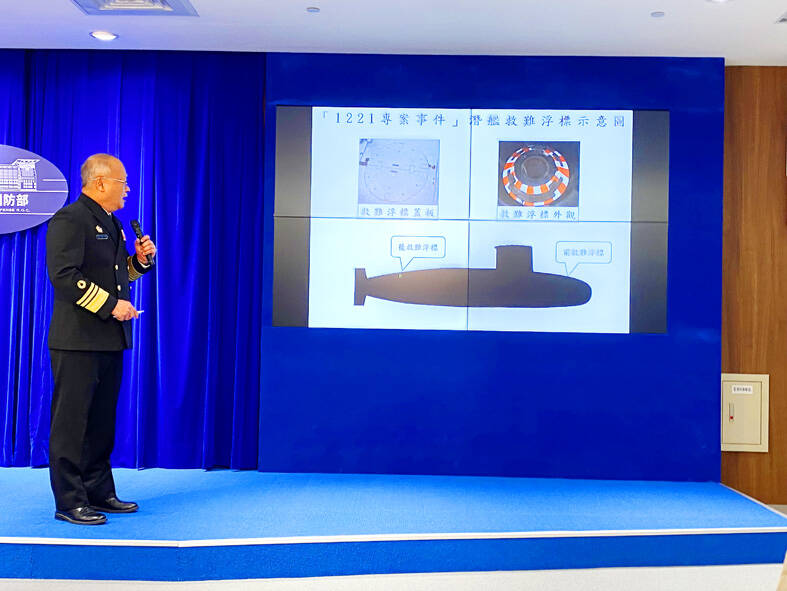Rogue waves are likely to blame for an incident last week that left three members of a submarine crew missing, the navy said yesterday, as it presented a timeline of what happened.
A master chief petty officer surnamed Lin (林) and two petty officers surnamed Yen (顏) and Chang (張) remain missing after being swept off the Hai Hu (海虎, Sea Tiger) submarine on Thursday last week, Chief of Naval Staff Vice Admiral Wu Li-ping (吳立平) told a news conference, adding that the military has dispatched 80 aircraft and 76 vessels in a rescue mission involving 981 people.
“We won’t leave our comrades behind,” Wu said, adding that the military would not call off the search-and-recuse mission until they find the missing crew members.

Photo: Wu Su-wei, Taipei Times
The navy on Sunday said it would continue the rescue mission for at least another 72 hours following the elapsing of the first 72 hours — also known as the “golden period” for search-and-rescue missions.
Preliminary indications show that the weather conditions, in particular winds measuring a five on the Beaufort scale, were within safety standards on Thursday last week, and that an unexpected surge in the sea was likely the main reason the sailors were swept away, Wu said.
The incident occurred after the Hai Hu departed from Kaohsiung on Monday last week for a training mission in waters off southeastern Taiwan that was set to conclude on Friday, he said.
At about noon on Thursday last week, while operating under the sea, crew members heard “abnormal sounds” coming from the rear of the vessel that they eventually determined was coming from one of the submarine’s rescue buoys.
The buoy was floating outside the submarine after the wooden cover of its compartment fell off, for reasons the navy has yet to determine.
Fearing that the 300m steel cable the buoy was attached to could damage the submarine’s propeller blades, the captain brought the submarine to the surface and ordered crew members to recover the buoy, Wu said.
Four sailors were sent out initially, all of whom wore life jackets and were tethered to the deck by a safety harness. Three of them were swept overboard by a rogue wave, with one of the three saved because of his safety harness.
The navy determined that the buckles connecting the missing sailors to the safety line had deformed and came loose under the stress of the weather conditions, Wu said.
After hearing that crew members had fallen overboard, the submarine’s weapons system chief went to the deck to aid in the rescue, resulting in him also falling into the sea, before being quickly recovered, he said.
The captain then dispatched six members of the vessel’s rescue team to the deck to find the missing sailors, while also trying to retrieve the buoy.
A member of that team also fell overboard due to a rogue wave and went missing, Wu said.
The Hai Hu is one of two Chien Lung-class (Sword Dragon) submarines Taiwan purchased from the Netherlands in the 1980s, the other being the Hai Lung (海龍, Sea Dragon).
Taiwan also possesses two World War II submarines purchased from the US in the 1970s, but they are now used exclusively for training purposes.

An essay competition jointly organized by a local writing society and a publisher affiliated with the Chinese Communist Party (CCP) might have contravened the Act Governing Relations Between the People of the Taiwan Area and the Mainland Area (臺灣地區與大陸地區人民關係條例), the Mainland Affairs Council (MAC) said on Thursday. “In this case, the partner organization is clearly an agency under the CCP’s Fujian Provincial Committee,” MAC Deputy Minister and spokesperson Liang Wen-chieh (梁文傑) said at a news briefing in Taipei. “It also involves bringing Taiwanese students to China with all-expenses-paid arrangements to attend award ceremonies and camps,” Liang said. Those two “characteristics” are typically sufficient

A magnitude 5.9 earthquake that struck about 33km off the coast of Hualien City was the "main shock" in a series of quakes in the area, with aftershocks expected over the next three days, the Central Weather Administration (CWA) said yesterday. Prior to the magnitude 5.9 quake shaking most of Taiwan at 6:53pm yesterday, six other earthquakes stronger than a magnitude of 4, starting with a magnitude 5.5 quake at 6:09pm, occurred in the area. CWA Seismological Center Director Wu Chien-fu (吳健富) confirmed that the quakes were all part of the same series and that the magnitude 5.5 temblor was

The brilliant blue waters, thick foliage and bucolic atmosphere on this seemingly idyllic archipelago deep in the Pacific Ocean belie the key role it now plays in a titanic geopolitical struggle. Palau is again on the front line as China, and the US and its allies prepare their forces in an intensifying contest for control over the Asia-Pacific region. The democratic nation of just 17,000 people hosts US-controlled airstrips and soon-to-be-completed radar installations that the US military describes as “critical” to monitoring vast swathes of water and airspace. It is also a key piece of the second island chain, a string of

The Central Weather Administration has issued a heat alert for southeastern Taiwan, warning of temperatures as high as 36°C today, while alerting some coastal areas of strong winds later in the day. Kaohsiung’s Neimen District (內門) and Pingtung County’s Neipu Township (內埔) are under an orange heat alert, which warns of temperatures as high as 36°C for three consecutive days, the CWA said, citing southwest winds. The heat would also extend to Tainan’s Nansi (楠西) and Yujing (玉井) districts, as well as Pingtung’s Gaoshu (高樹), Yanpu (鹽埔) and Majia (瑪家) townships, it said, forecasting highs of up to 36°C in those areas